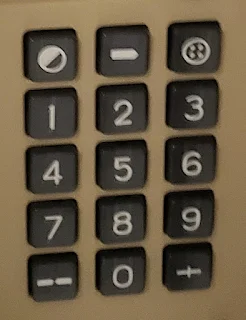Ah, the ubiquitous DTMF keypad still has some relevance as a modern communications tool in the age of voice assistants, location technology and digital communications. Lets find out if that is true.....
What is DTMF?
When you press the buttons on a telephone or most radio keypads, a connection is made that generates two tones at the same time. A “Row” tone and a “Column” tone. These two tones identify the key you pressed to any equipment you are controlling. If the keypad is on your phone, the telephone “Central Office” equipment knows what numbers you are dialing by these tones, and will switch your call accordingly.
If you are using a DTMF keypad to remotely control equipment, the tones can identify what unit you want to control, as well as which unique function you want it to perform.
How do you dial satellites with DTMF Mr. President?
Not all amateur radio satellites focus on providing voice, packet, location or image sharing. A few have incorporated APRStt which makes for novel quick communication of both user call sign and location using one nice short string of DTMF codes.
Any one who has watched or conducted amateur satellite activity may be familiar with the grid square or maidenhead location system. Using only two capital letters, two numbers and two lower case letters can the geographic position with accuracy of 7.5 miles.
While that may not seem too accurate, its good enough for quick general location exchange. Simply speaking into a radio that you are located in FN31 or FN31bw is far easier than saying 38°53'52.6"N 77°02'11.4"W or even 38.897933, -77.036500.
Using APRStt, you can simply press *13315246402164# which works out to K2GOG located in FN31bw. The time it takes to send 16 characters is less time than it took to read this last sentence.
For those interested in data satellite communications, but do not own a radio capable of the popular AX.25 based 1200 baud APRS functionality like the Kenwood TH-D72, TH-D74 and the newish Lanch HG-UV98 to be reviewed on HVDN later this summer, this may be an interesting communication method to experiment with. Courtesy of Bob Wood, WA7MXZ, here is a nice calculator to compute your own APRStt sentence.
Any amateur radio with a DTMF keypad from the lowly $25 BaoFeng radios, to more current mainstream radios like the Yaesu FT-70R and about 300+ other models to the super cool looking military "knock off" variants of the PRC-152 found on E-Bay would work just the same for APRStt since they can all send DTMF.
But how to decode APRStt?
DTMF is hard by ear to determine the DTMF code sent, so the soon to launched PSAT2 includes a DTMF to voice transponder which will read back via computer generate voice a fully formed APRStt sentence it receives. There are also many other very interesting things that PSAT2 will also permit such as:
- PSK31 10m band up-link/UHF FM down-link
- SSTV camera with UHF down-link in the same pass-band as PSK31 signals
- DTMF Grid Square up-link and Voice/APRS down-link for Grid position reporting
- DTMF Text messaging (APRStt).
- APRS text messages up and Voice down.
- Conventional APRS digipeater
Some may choose to experiment with an SDR tuned to the appropriate PSAT2 frequencies and decode APRStt with suitable software or maybe even use an Arduino based simple DTMF decoder since not many amateur radios can decode DTMF easily.
The radios that can and often include other uses for DTMF multi tone decoders and could be programmed ahead of time to un-mute when a known APRStt is heard, but that sounds frustrating. Maybe someone will "hack" a TYT MD-380 or other to show DTMF since it is capable at multi tone decode? Hmmm.....
PSAT2 details please?
Once this interesting cube-sat reaches orbit and is provisioned for operations after the June 23rd or 24 or 24th 2019 launch window, we will be able to track the satellite and hopefully learn if 28.120 MHz is the actual 10m frequency to be used for the PSK31 transponder up-link or not.
PSAT2 is sure to be an exciting satellite and we wish it success and to help continue to make ham radio great again!
Related Reading







No comments:
Post a Comment
We really do not want to moderate comments, so lets keep it easy to use until it becomes an issue.